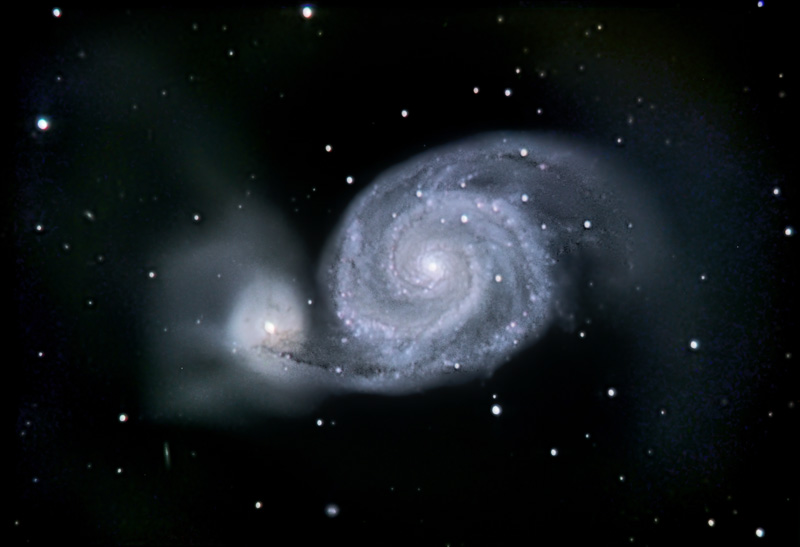

Image Centered on Ra. 13 : 29.9 (h:m) Dec. +47 : 12 (deg:m) Distance 37 million Ly
Information (from the seds online website)
Discovered 1773 by Charles Messier.
The famous Whirlpool galaxy M51 was one of Charles Messier's original
discoveries: He discovered it on October 13, 1773, when observing a comet, and
described it as a "very faint nebula, without stars" which is difficult to see.
Its companion, NGC 5195, was discovered in 1781 by his friend, Pierre Méchain,
so that it is mentioned in Messier's 1784 catalog: `It is double, each has a
bright center, which are separated 4'35". The two "atmospheres" touch each
other, the one is even fainter than the other.' NGC 5195 was assigned an own
number by William Herschel: H I.186.
Occasionally, there is some confusion what is meant with the designation M51:
The pair (justified by Messier's mention of both "nebulae") or the larger
galaxy, NGC 5194. If the pair is meant, NGC 5194 is sometimes called "M51A", and
NGC 5195 is then "M51B".
M51 is the dominating member of a small group of galaxies. As it is about 37
million light years distant and so conspicuous, it is actually a big and
luminous galaxy. The value of M51's (and the whole group's) distance is still
not very well known. Our value, of 37 Mly, is based on photometric methods and
e.g. given by Kenneth Glyn Jones. Some authors give significantly lower values
(less than 20 Mly), but a recent (2001) STScI Press Release gave 31 million
light years.
This galaxy was the first one where the spiral structure was discovered, in
spring 1845 by Lord Rosse, who made a very careful and acurate painting.
Therefore, M51 is sometimes referenced as Rosse's Galaxy or Lord Rosse's
"Question Mark" - he is cited with this name (see, e.g., NED).
According to our present understanding, the pronounced spiral structure is a
result of M51's current encounter with its neighbor, NGC 5195 (the fainter one
in Messier's description). Due to this interaction, the gas in the galaxy was
disturbed and compressed in some regions, resulting in the formation of new
young stars. As is common in galactic encounters, spiral structure is preferably
induced in the more massive galaxy. Halton Arp has included M51 as No. 85 in his
Catalogue of Peculiar Galaxies as "Spiral with Large High-Surface-Brightness
Companion".
For the amateur, M51 is easy and a showpiece if the sky is dark, but is quite
sensitive for light pollution which easily makes it fade in the background.
Under very good conditions, even suggestions of its spiral arms can be glanced
with telescopes starting from 4-inch. Low magnification is best for viewing this
pair.
Optics and exposure data
Telescope Celestron 9.25 SCT operating at f6.3 with a Meade focal Reducer
Imager Starlite-Xpress SXV-H9 Using Astronomiks RGB filters
Mount Losmandy G11 with Gemini Control Electronics.
90 minutes luminance with 2 minute subexposures, RGB each channel = 15 minutes with 2 minute subexposures.
Image acquisition using Astroart then aligned and combined with Maxim Dl. Final processing was accomplished using Photoshop Cs
Images acquired from my backyard - " Dirt Clod Observatory" in Antelope California